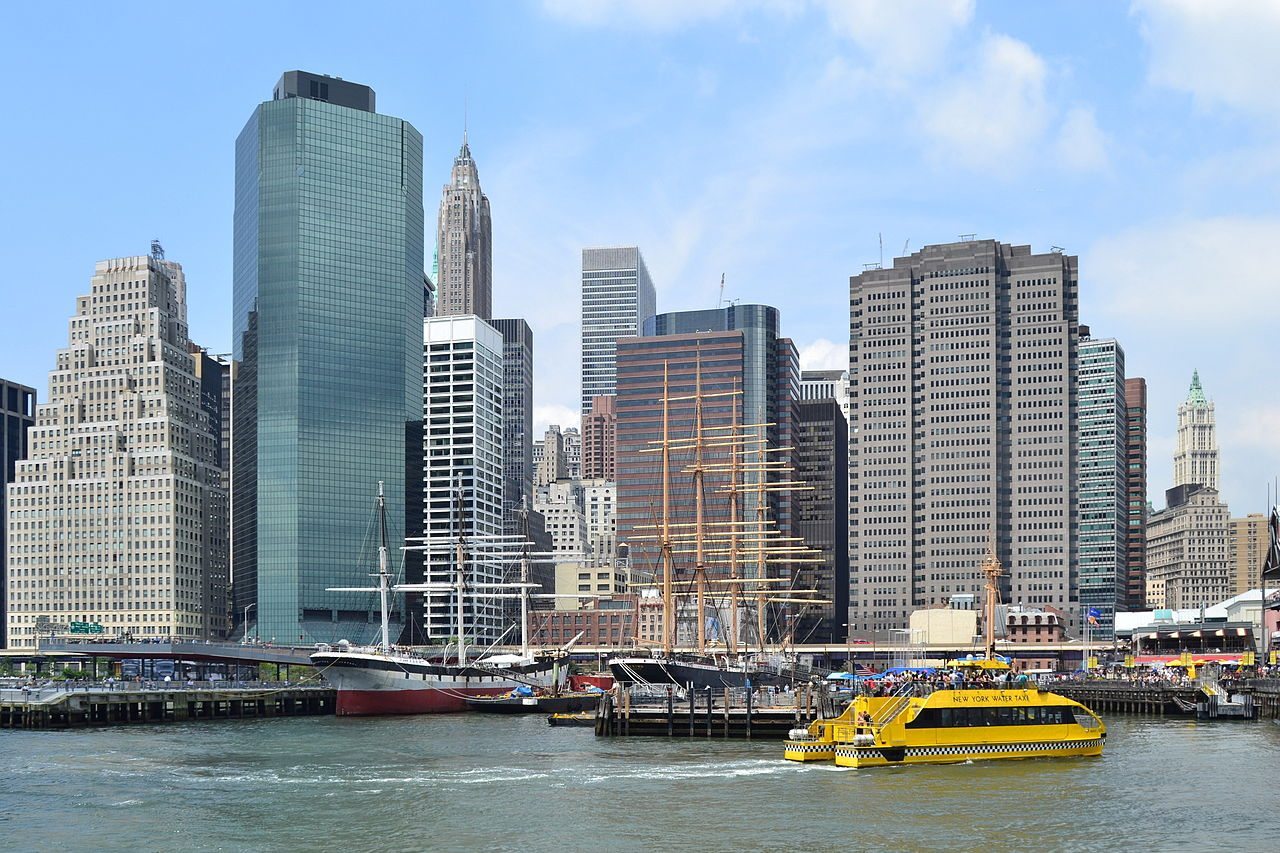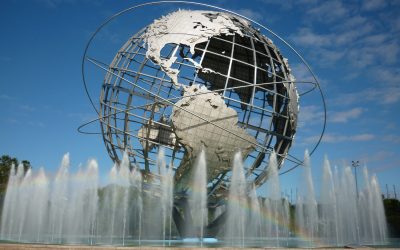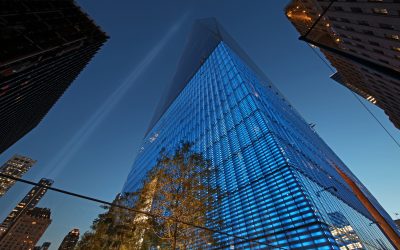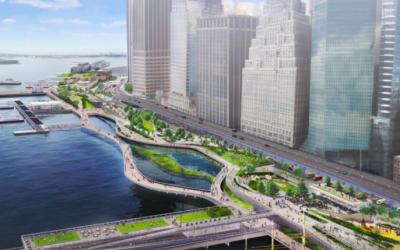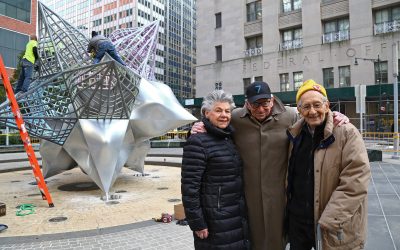
Photo: courtesy of commons.wikimedia.org
When the first rumors of Hurricane Joaquin began to brew on the horizon earlier this week, many New Yorkers felt a twinge of anxiety. For most, the ravages of Hurricane Sandy are an all too-recent injury. But that didn’t stop a small crowd of downtown residents and interested folk from gathering at Pier 15 on Thursday afternoon for the first in a series of Archtober educational tours, hosted by the South Street Seaport Museum. The sky was noticeably darkened as William Roka, Operations Assistant and a scholar of the Seaport’s maritime history, addressed a group of listeners with their coats zipped up against the sudden drop in temperature.
The South Street Seaport Museum opened its doors in 1967 as a non-profit cultural institution dedicated to preserving the history of New York as a great port city. And there is a lot of history in the area to preserve, especially since Sandy hit the Seaport in 2012. The neighborhood was listed as one of the 11 most endangered historic places in the United States by the National Trust for Historic Preservation earlier this year. This is due in part to the Howard Hughes Corporation’s controversial plans to redevelop the area—the proposed plans would feature a 494-foot condo high rise near Pier 17—but there has also been a dire lack of funding made available for fortifying the architectural and cultural landmarks of the port. Meanwhile, the South Street Seaport Museum itself remains mostly closed, post-Sandy, aside from its lobby.
“It’s heartbreaking that the public can’t visit the upper floors of the museum and view the paintings and artifacts,” said Morning Slayter, a private art dealer and South Street resident who is a docent at the Museum. “The Seaport was devastated by Sandy and I don’t think we are ready to deal with Hurricane Joaquin,” she added.
Now, three years later, the people of Lower Manhattan are still grappling with some very overwhelming issues. Aside from disaster recovery, an expensive and complex endeavor by itself, downtown residents find themselves faced with an increasingly alarming fact: This is going to happen again. Climate experts have been warning us for decades that sea levels are rising, and New York is in an especially precarious place.
By 2050, the water in the New York Harbor is predicted to be as much as 30 inches higher than it is today, making the area more vulnerable to storm surges like Joaquin. Not only that, the Eastern Seaboard is actually sinking. This factoid goes back to the last ice age, which peaked around 20,000 years ago. A massive ice sheet used to stretch over Canada, weighing down the earth’s crust and causing areas away from the ice to bulge upwards. Now that the ice sheet has melted, the ground that was directly beneath it is rising, and the bulged areas are falling.
Essentially, the entire eastern coast of the United States, from southern Maine to northern Florida, is sinking. The sinking is happening fastest in the Chesapeake Bay region of Maryland and Virginia, where entire islands that used to have towns on them have already disappeared. New York is not sinking quite so fast, but the city is up against a fascinating problem. Not only is New York the most populous city in the United States, but Manhattan headquarters the world’s financial center. Not to mention its stunning architecture, art museums and universities. There is a lot of expensive real estate on this sinking island, and for the people whose livelihoods are invested here, the stakes are very high.
So, let’s talk “disaster resiliency.” This term refers to the city’s efforts to strengthen its coastal defenses. This involves retro-fitting old buildings for flood protection and constructing new buildings according to higher standards of storm preparedness. Interestingly, the downtown neighborhood that weathered Hurricane Sandy the best was Battery Park City, due in large part to its sustainable “green” buildings, erected mostly in the 1980s, as well as incorporating an increased elevation and fortified waterfront edge along the Hudson River. But to the older neighborhoods, like the South Street Seaport, incorporating sustainable flood protection poses an interesting challenge. The community members rising to meet this challenge are not faint of heart.
“It’s an extremely complicated thing. It involves multiple strategies and organizing people. You can’t just build a wall and hope we’ll be fine,” said Marco Pasanella, proprietor of Pasanella & Son Vintners at 115 South Street. Pasanella is also the Chair of Manhattan Community Board 1’s South Street Seaport/Civic Center Committee and former Chair of the Old Seaport Alliance, a group he founded in the wake of Hurricane Sandy to be the voice of local businesses in the South Street Seaport neighborhood.
“The Seaport was the most hard hit,” he explained. “It’s the oldest part of the city. It’s been frustrating.”
Strategies for flood prevention in the past have included piling up sandbags as barriers, or, more recently, surrounding buildings with heavy-duty plastic tubes, which are designed to fill with water in the event of a flood. In order to comply with new federal regulations, many older buildings have been required to relocate all their critical systems to higher floors. But for many building owners, this process has proved difficult and costly.
Because Lower Manhattan is the portion of the island most exposed to extreme weather disasters, Mayor Bill de Blasio recently allotted $100 million to constructing a flood protection system around the lower tip of Manhattan. The project will employ methods like levees, flood walls, and more park land to soak up storm water. The city is also in the process of applying for a federal grant through the National Disaster Recovery Competition (NDRC). New York stands to win as much as $500 million, of which Lower Manhattan hopes to secure $234 million for its disaster resiliency efforts.
But while these projects are designed to tackle long-term solutions, many members of the community remain extremely worried about the short term, as the current scare about Joaquin illustrates. The city’s proposed flood protection system could take as long as 10 years to build. Even if Joaquin doesn’t hit New York, there is a lot of climate research that suggests the walls of the Battery will be breached again soon enough. Residents and business owners are wracking their brains, trying to find an answer to this troubling question: What if we get flooded again tomorrow?
Pasanella suggests the idea of placing caches of emergency supplies and generators inside waterproof containers around the neighborhood. These containers would need to be attached securely to the ground somehow, but they might offer a relatively low-cost solution, compared to other short-term options. Such a container could be stored under the Brooklyn Bridge, for example.
Manhattan’s Community Board 1 Chair, Catherine McVay Hughes, who has been instrumental in rallying funds and support for the Community District 1, also cautions: “We remain gravely concerned by the lack of short to medium range strategies to protect CB 1 in the event of another large storm.” She encourages local businesses and community members to continue to participate in the City’s public hearings about funding, even as the Hughes building development moves forward.
Of course, the anxiety about keeping Manhattan afloat is far from new. As early as 1824, rumors were circulating amongst city merchants that the southern tip of the island was sinking due to the sheer weight of urban development. There is even an urban legend about a ship carpenter who proposed Manhattan could be stabilized by cutting the island, towing it out, rotating it 180 degrees, and putting it back in place. He intended this as a prank, but, surprisingly, the community’s main concern was not the improbability of the idea; rather, they got caught up on the fact that Long Island was in the way. This particular story remains unverified, but nevertheless it has lodged itself into that grim and glittering canon of anecdotes that only downtown residents will ever understand.
The reality of the situation is that Lower Manhattan is just one of many communities in the coastal area to be threatened by climate change. New York City as a whole has more waterfront area than Miami, Boston, Los Angeles and San Francisco combined. And by 2050, FEMA estimates that nearly 400,000 of the city’s residences will fall into expanded flood danger zones. Not to mention the rest of the East Coast.
There is a beautiful line from Walt Whitman’s poem, “City of Ships,” engraved across a railing near the North Cove Marina in Battery Park City: “City of wharves and stores—city of tall facades of marble and iron!” This is a line that speaks to the enduring spirit of New York City. In many ways, New York is a fortress.
And while it may be true that rats are the first to abandon a sinking ship, in this case, it would seem the diehard warriors of New York’s “rat race” (please, forgive the pun) aren’t going anywhere any time soon. It is precisely this spirit of courage and grit that makes New Yorkers the endlessly delightful characters that they are.
As Roka joked at the conclusion of his talk on Thursday, “We New Yorkers haven’t figured out how to walk on water yet!” But the implication was this—if anyone can, it is the people of New York.
-by Rachel Veroff
Editor’s note: this article has been modified to clarify that New York City’s application for disaster resiliency funding includes four proposals totaling $622 million, but a single municipality can only win up to $500 million.

